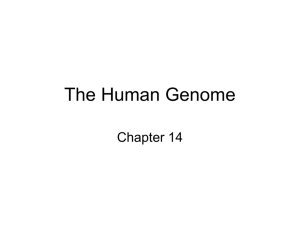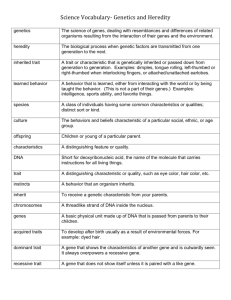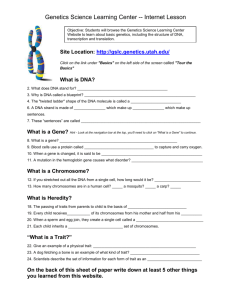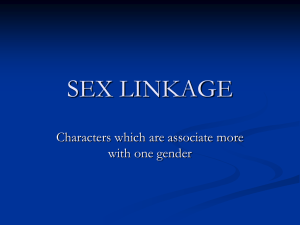Genetic Test Study Guide
advertisement
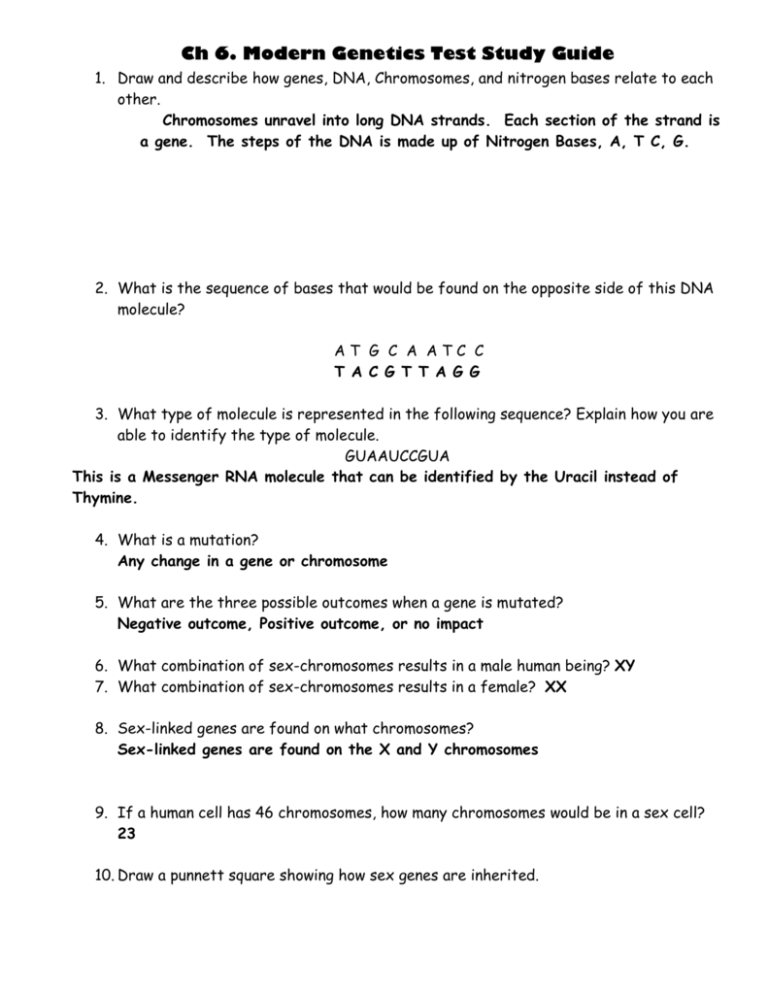
Ch 6. Modern Genetics Test Study Guide 1. Draw and describe how genes, DNA, Chromosomes, and nitrogen bases relate to each other. Chromosomes unravel into long DNA strands. Each section of the strand is a gene. The steps of the DNA is made up of Nitrogen Bases, A, T C, G. 2. What is the sequence of bases that would be found on the opposite side of this DNA molecule? AT G C A ATC C T A C G T T A G G 3. What type of molecule is represented in the following sequence? Explain how you are able to identify the type of molecule. GUAAUCCGUA This is a Messenger RNA molecule that can be identified by the Uracil instead of Thymine. 4. What is a mutation? Any change in a gene or chromosome 5. What are the three possible outcomes when a gene is mutated? Negative outcome, Positive outcome, or no impact 6. What combination of sex-chromosomes results in a male human being? XY 7. What combination of sex-chromosomes results in a female? XX 8. Sex-linked genes are found on what chromosomes? Sex-linked genes are found on the X and Y chromosomes 9. If a human cell has 46 chromosomes, how many chromosomes would be in a sex cell? 23 10. Draw a punnett square showing how sex genes are inherited. 11. Explain why males are more likely to have recessive traits on the X chromosome. They are more likely because they only need to receive 1 recessive allele from his mother on the X-chromosome to have the trait. 12. What is a pedigree used for? To track which family members have a particular trait. 13. On the pedigree, circle those who carry the allele for a particular trait, write M below any males and an F below any females. st nd rd 14. Next label the placement of the 1 , 2 , and 3 generations on the pedigree. 15. Using the pedigree, how many individuals in the 2nd generation are carriers? 3 16. How many individuals in the 3rd generation on pedigree are affected by the trait? 1 17. A carrier is a person who has what? One recessive and one dominant allele for a trait but does not have the trait 18. The following is a sequence of DNA. Describe the steps of it will takes during the process of protein synthesis. Use the words replication, transcription and translation in your description as well as where the process will take place. ACGTAGT During REPLICATION Messenger RNA will make a copy of the DNA paired strand. Thymine will be replaced by Uracil. The mRNA will leave the nucleus and go to the cytoplasm where it will attach to a ribosome. This process is called Transcription. Then Transfer RNA reads the 3-letter codes on the mRNA and starts adding Amino Acids to a protein chain until the code reads to stop. This process is called Translation. 19. State and describe the 3 methods for developing organisms with desirable traits. a. Selective Breeding-selecting organisms with desired traits to be parents of the next genereation b. Cloning-producing organisms that have exactly the same genes as another organism c. Genetic Engineering-geneticists transfer genes from one organism into the DNA of another organism. 20. Cloning results in two organisms that are genetically identical. 21. One turkey is a wild turkey and the other is raised for meat. Circle the turkey that is a result of selective breeding. The larger one 22. What are examples of the benefits to humans of genetic engineering? 1. Making clotting proteins or insulin valuable in treating human diseases. 2. Creating disease or cold resistant plants 3. Gene therapy to help cure genetic diseases

